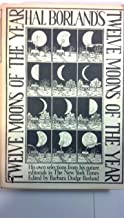Twelve Moons of the Year, Hal Borland 1979
Hal Borland wrote a ‘nature editorial’ in the New York Times Sunday edition from 1942 to 1973, his 1750 columns about the outdoors and nature in New England, a fixture of the newspaper. From his home along the Housatonic River in the Berkshires, Borland wrote lyrical and lucid prose about the weather, the flora and fauna, the geology, and the seasons. His wife, Barbara Dodge Borland, selected portions of 365 of those columns for this volume, one for each day of the year organized by month with each chapter titled with that month’s ‘moon’, e.g. December is the Cold Moon. It was 12 degrees outside in Brownsville on the shortest day of the year with only 8 hours and 57 minutes of daylight coming when I finished this book this dark morning. Borland’s entry for today reads: “The year achieves another solstice as the great wheel of time turns with the earth and the seasons. Winter, by the calendar, begins in mid-morning today, though the year’s shortest days have been upon us for almost a week. The solstice is a marker on the charts, but winter abides by its own schedule of wind and weather.” Classic Borland—informative, factual, and yet poetic in its rhythms and wording. This is a fine book to keep on your nightstand and read along, day by day, month by month, as the year unfolds. Borland, now largely forgotten, is one of our great nature writers along with Edwin Way Teale, Joseph Wood Krutch, Aldo Leopold, and Bernd Heinrich, all following in the footsteps of Gilbert White, who chronicled a year in his Selborne, England garden in 1784, setting the model for the naturalist’s journal.



